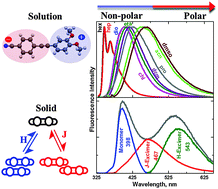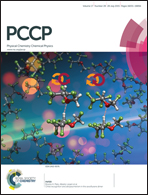Transformation of photophysical properties from solution to solid state in alkoxy-cyano-diphenylacetylene molecules†
Abstract
Detailed photophysical properties of cyano and mono (MA)/bis alkoxy (DA) substituted diphenylacetylene moieties with different alkyl chain lengths (methyl (1), octyl (8) and dodecyl (12)) were investigated in solution and the solid state in an effort to determine the effect of self-aggregation on these properties. The solvated molecules showed a minimal bathochromic shift with an increase of solvent polarity in their absorption spectra, whereas a significant shift was observed in the emission spectra. This could be attributed to the relatively low change in dipole moment between ground and Franck–Condon excited states and luminescence arising from the intramolecular charge transfer state with a dipole moment significantly higher than that of the ground state. In solid state the emission quantum yields of these materials were significantly higher than in solution. For DA1, polymorphic materials with distinct photophysical properties were obtained. The DA1 materials obtained by fast precipitation (DA1) showed broad fluorescence with peaks at 398, 467 and 535 nm upon excitation at different wavelengths. Detailed analysis of absorption, emission and excitation spectra and lifetime experiments indicated that these peaks could be attributed to the monomer, J- and H-type aggregates respectively. Whereas the crystals obtained by slow crystallization (DA1C) showed only one emission peak at around 396 nm attributed to the monomer. This is supported by the single crystal X-ray structure which consists of a monomer molecule having minimal interaction with nearest neighbour molecules.


 Please wait while we load your content...
Please wait while we load your content...